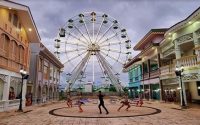A Glimpse of Eternity The Ruins in Bacolod City’s Realm
One such example is the Ruins in Talisay City, Negros Occidental. Known as The Taj Mahal of Negros, this magnificent mansion was built by Don Mariano Ledesma Lacson in memory of his beloved wife Maria Braga. Unfortunately, it was burned down during World War II but has since been restored and transformed into a tourist attraction. The Ruins stands as a testament to undying love and resilience amidst destruction. Another remarkable ruin can be found on Corregidor Island, known as The Rock. This small island played a significant role during World War II as it served as one of the last strongholds against Japanese forces.
Today, visitors can explore various remnants from that era including barracks, tunnels, and gun emplacements. Walking through these ruins evokes feelings of both awe and solemnity while paying tribute to those who fought for freedom. In Ilocos Norte lies Paoay Church or St. Augustine Church – an architectural marvel recognized by UNESCO as a World Heritage Site. Built-in 1704 using coral stones and bricks made from sugarcane juice mixed with lime mortar; this church showcases Baroque architecture fused with local influences resulting in an impressive structure that has stood for centuries despite numerous earthquakes.
Further south in Cebu City stands Fort San Pedro – considered to be one of the oldest forts in the Philippines dating back to 1565 when Spanish conquistadors first arrived on Philippine shores led by Miguel Lopez de Legazpi. Tracing History The Enigmatic Ruins of the Philippines The Philippines, a Southeast Asian archipelago known for its stunning beaches and vibrant culture, is also home to some of the most enigmatic ruins in the world. These ancient structures offer a glimpse into the rich history and diverse civilizations that once thrived on these islands. One such site is the Banaue Rice the ruins Terraces, often referred to as the Eighth Wonder of the World. Carved into mountainsides over 2,000 years ago by indigenous tribes using only hand tools, these terraces are a testament to human ingenuity and perseverance.



